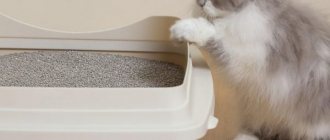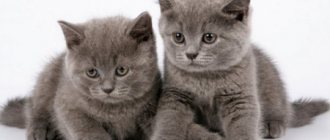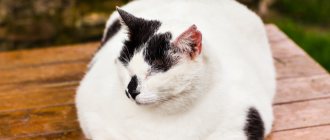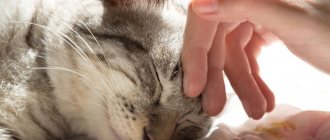Heavy breathing, like many other changes that occur in a pet’s body, causes concern among caring breeders. This is understandable, because the animal cannot talk about the pain or discomfort it experiences, so recognizing the problem in time and providing the necessary help is an important task for the owner. Let's figure out what could be the reasons why a kitten is breathing heavily and what to do if such a condition is detected.
Features of the respiratory system of kittens
The respiratory system of a kitten is not too different from a human:
1. Inhalation: the lungs inflate, due to which air is drawn through the nose, where it is warmed and filtered, passes through the pharynx into the larynx, from there into the trachea, then into the bronchi and lungs.
2. From the lungs, oxygen enters the blood and is distributed throughout the cells of the whole body.
3. Exhale: the diaphragm relaxes, nitrogen, oxygen and carbon dioxide are removed from the bronchi.
In addition to supplying the blood with oxygen, breathing performs the function of thermoregulation by removing excess fluid.
The respiratory rate of adults is on average 30 inhalations and exhalations per minute, in kittens it is approximately 40-50. Moreover, this indicator is approximate and unstable; it depends on many factors, both the environment and the internal state of the animal.
Breathing Features of Cats
The breathing process of a cat is not fundamentally different from other mammals, including humans. When an animal breathes, air is drawn in through the nose, enters the larynx, and from there through the trachea is sent to the lungs. Next, oxygen is picked up by the blood and distributed to all organs of the body. "Waste" goes back along the same path:
- lungs;
- trachea;
- larynx;
- nasal passages.
In a calm state, a cat breathes approximately 30 times per minute, that is, every two seconds. The norm is the number of breaths from 20 to 40. In kittens this figure is slightly different and can reach 50 times.
Rapid breathing in adult cats is observed when they are frightened, excited, or angry about something. For example, while traveling in public transport, meeting a dog or during active games. You can also notice that the pet is breathing frequently and its stomach is heaving if the cat is very hot.
Another reason for deviation is the female’s prenatal condition or estrus. All these situations can be considered a variant of the norm. Very little time passes, the cat calms down and breathes as usual again. However, sometimes we are talking about deviations.
The kitten is breathing heavily - the reasons are within the norm
Even if a kitten is breathing heavily and frequently, this does not always mean that there are some serious health problems; the reasons for intense breathing can be quite harmless:
1. Most often, normal increased breathing is associated with stress experienced by the animal. It can be caused by many circumstances:
· any medical interventions and treatment procedures, from injections to taking pills.
· visiting unfamiliar places, for example, a veterinary hospital.
· traveling in a car, bus or other vehicle.
· contact with other animals, children, strangers.
2. The kitten begins to heat. Adults also experience changes in the body such as pregnancy and childbirth.
3. Food absorption.
4. Overheating.
5. Increased physical activity during games and running.
All these situations do not pose any threat to the life and health of the pet. After eliminating the causes that caused the increase in frequency, breathing returns to normal. It is important to remember that stressful situations can cause other health problems for the kitten and should be avoided if possible.
Causes
Below we will discuss the top seven reasons why your cat is panting. Some causes do not require medical attention, but for more serious causes of wheezing, you should immediately consult a veterinarian you trust.
© shutterstock
- Excessive play time in extreme heat . One common reason your cat is panting is due to overheating. This may occur due to excessive play or exercise in hot climates. If your furry friend is panting as a result, stop your cat from any further activity and help her relax and cool down.
- Your cat is experiencing sudden stress . If there is a sudden change in your home, such as a new guest, a new pet, or a new building, your cat may become nervous and panting.
- Asthma . It may come as a shock to you, but cats are just as prone to asthma as humans. With this condition, your cat may develop allergies to environmental particles, which causes a narrowing of the air passages in the lungs.
- Respiratory tract infection . Your four-legged friend's respiratory tract may be infected with a virus, bacteria, fungus, or any other pathogen. This infection can lead to inflammation of the respiratory tract.
- Anxiety . An anxious cat will often pant and exhibit several other signs, such as strange behavior, excessive grooming, frequent urination, and changes in diet.
- Heart disease . Your cat can contract this disease from the bite of an infected mosquito. Signs include cough, shortness of breath and difficulty breathing. Talk to your veterinarian about measures to prevent this disease.
- Chronic heart failure . This is a serious disease that causes thickening of the heart muscles. This causes the heart to beat much faster, causing cats to pant. Your veterinarian will put your furry friend on oxygen therapy if a heart attack occurs.
When to urgently contact a veterinarian
Many of these conditions are extremely dangerous and can lead to death. The success of treatment largely depends on how quickly treatment begins. In order not to miss the moment when treatment is possible, it is worth knowing the symptoms for which you need to show your pet to a doctor as soon as possible. This must be done if, in addition to rapid breathing, the following are observed:
- temperature increase;
- increased heart rate;
- wheezing in the chest;
- nasal discharge;
- discharge from the oral cavity;
- too pale or red tint of mucous membranes.
Help with difficulty breathing in a cat
At home, your pet needs to be given peace. Do not try to give the cat water or force it down, or use medications. The best help is to take the animal to a veterinarian as quickly as possible.
Depending on the symptoms and condition of the cat, the doctor’s help may include the following:
- placing the pet in an oxygen chamber or supplying oxygen using a mask;
- if a foreign body is detected, remove it from the respiratory tract;
- for serious bruises - a puncture of the chest.
Heavy breathing in a cat can be caused by hidden diseases, including: bronchial asthma or heart disease, found in Sphynx or British cats. It should be remembered that cats have a very vulnerable respiratory system. Therefore, any breathing problems in your pet should be shown to a doctor.
What will the veterinarian do if the kitten is breathing heavily?
When a kitten is seen by a veterinarian due to rapid breathing, specialists usually carry out the following procedures:
— Questioning the owner about the time when rapid breathing was noticed, the presence or absence of associated problems and possible natural causes.
— Visual examination of the animal, during which the doctor determines whether the body is dehydrated, what condition the mucous membranes are in, etc.
— Temperature measurement.
— Detection of helminthic infestation.
— Prescribing the necessary additional laboratory tests. For example, a blood test to rule out anemia or infectious diseases.
— Referral for an ultrasound or x-ray if there is a suspicion of heart disease or other internal organs.
— A puncture of the chest wall (thoracentesis), which allows you to determine whether there is excess air or fluid in the chest cavity. Used only in extreme cases.
Treatment of reactive pancreatitis in children
If symptoms of pancreatitis appear, you should immediately consult a doctor. Some forms of pancreatitis require intensive care in a hospital setting!
Diagnosis of the disease is carried out using a blood test (biochemistry) and ultrasound examination of the abdominal cavity. If the diagnosis is determined correctly, then the treatment of reactive pancreatitis in children has the same principles as the treatment of the acute form of the disease.
The treatment mechanism for reactive pancreatitis includes diet and complex drug therapy. These could be antibiotics, enzymes, antihistamines - the correct drug treatment regimen should be determined by a doctor.
Causes of wheezing
There are many factors why a cat coughs. Among the main ones are allergic reactions, foreign bodies in the respiratory tract, bronchial asthma, helminths, inflammatory processes in the lungs, viruses and heart disease.
An allergic reaction in a cat occurs when an irritant enters the respiratory tract. Allergies can be caused by household dust, chemicals (detergents, aerosols, tray fillers), low-quality dry food and chemicals used for repairs.
Some cats suffer from allergies caused by seasonal flowering plants. Cough also occurs in cats whose owners smoke. When the animal breathes, gurgling and wheezing sounds can be heard.
Another cause of coughing in a cat is foreign objects stuck in the throat or nasal passages. These can be small bones and objects, as well as trichobezoars (balls of hair). In this case, the cat coughs and wheezes, trying to clear its throat and get rid of the irritating object.
Bronchial asthma is a dangerous condition of the animal’s body, the symptom of which is a strong, lingering cough and a general deterioration in the pet’s condition. Asthma is often associated with a genetic predisposition and can occur as a result of common allergies.
Cough can also be caused by helminthiasis. This is one of the most commonly diagnosed causes of animal cough.
Cat owners mistakenly believe that parasites exclusively affect the intestinal tract. In fact, lungworms are much more dangerous and often fatal, affecting the animal's respiratory system.
During breathing, the cat can hear wheezing, provoked by increased mucus production to quickly get rid of cysthelminths.
Pneumonia is a disease that affects the lower parts of the respiratory system. It usually occurs against the background of bacterial and viral infections of the respiratory tract, rarely developing independently. In addition to coughing, the animal experiences breathing disturbances, a large amount of sputum and mucus produced, a deterioration in the animal’s general condition and an increase in body temperature.
The cause of a specific reaction of the body in the form of a cough can be all kinds of viral infections that affect the nose, pharynx, bronchial tree and lungs. The most dangerous are viral rhinotracheitis and calcivirosis. In addition to coughing, the cat is diagnosed with apathy, depression of general condition and refusal to eat. Viral infections are often accompanied by an increase in body temperature to high levels.
Diseases of the heart muscle that provoke coughing are rarely diagnosed in domestic cats. If there is a disturbance in the functioning of the heart, the visible mucous membranes become cyanotic, shortness of breath and depression of the general condition are observed.
The owner of a mustachioed pet should carefully monitor the nature and strength of the cough, noting other accompanying symptoms. It is not recommended to self-medicate, since without an accurate diagnosis it is not possible to make a diagnosis and prescribe treatment. Moreover, by delaying a visit to a specialist, the owner only makes things worse. Especially when it comes to foreign bodies stuck in the respiratory tract, because the animal can die.
The cat is breathing heavily or symptoms of hydrothorax in cats
Hydrothorax is an accumulation of free fluid in the pleural cavity.
The pleural cavity is the space between the parietal (external) and visceral (internal) pleura. That is, this is the physiological gap between the two layers surrounding the lungs.
To better understand, you can pay attention to the diagram of the structure of the chest:
Normally, the pleural cavity contains up to 1-2 ml in cats (in large dogs up to 5 ml) of serous fluid. This fluid is produced by the capillaries of the intercostal arteries and is removed by the lymphatic system. It is necessary to ensure sliding between the layers of the pleura during breathing.
With various pathological processes, this fluid becomes more than normal, which subsequently causes difficulty breathing
Symptoms of hydrothorax: inspiratory shortness of breath (when it is difficult to inhale), involvement of the abdominal muscles in the respiratory process, tachypnea (increased breathing), cyanosis (cyanosis) of the mucous membranes, which can also be accompanied by an increase in temperature, refusal to feed, and lethargy of the animal.
Possible causes of hydrothorax: congestive heart failure, various pathologies of the lymphatic system, neoplasms of the chest cavity, mechanical trauma to the chest, viral diseases (for example, feline coronavirus infection), metabolic disorders (for example, hypoalbuminemia - decreased albumin in the blood), etc.
When an animal is admitted with symptoms of hydrothorax, it usually undergoes thoracentesis (puncture of the chest cavity) to evacuate accumulated fluid and facilitate breathing. Some animals require sedation (anesthesia) for this procedure. Oxygen therapy is also necessary. After stabilizing the animal’s condition, they move on to diagnostics. After thoracentesis, observation in a hospital setting is recommended.
To make an accurate diagnosis, various diagnostic measures are required: ultrasound and x-ray of the chest cavity, biochemical and morphological studies of effusion fluid, general and biochemical blood tests, tests for viral infections, CT/MRI diagnostics.
The success of treatment largely depends on the time elapsed from the moment the first symptoms appear until the owner contacts a veterinarian.
The branches of the network of veterinary clinics “Svoy Doctor” have everything you need for the prevention, diagnosis and treatment of your pet!
Veterinary doctor, surgical resident of the branch of the Dzerzhinsky SVK “Svoy Doctor” Stepina Lada Vladimirovna
The cat has shortness of breath, coughing and aggravated condition
Oksana, Komsomolsk-on-Amur
January 30, 2020
Hello, Alexandra.
I ask you for help to save the cat. We have been receiving treatment since December 3, but still no diagnosis. I went to the veterinary clinic because the cat was coughing and wheezing in November. I was away for a month since October, my husband said that the cat began to cough often (October), especially after eating. He used to cough when he drank running water from the tap while standing on the edge of the bathtub. Not for long, and then behaved perfectly, felt good. I have never been sick with anything. On December 3, 2019, an X-ray was taken at the veterinary clinic and they started injecting Amoxicillin for 5 days. The cat began to cough less often. Unfortunately, I got sick myself and we arrived at the clinic a week later. They prescribed injections of furosemide 0.5-2 rubles per day for 3 days and Ambroxol 1/3 tablet 3 rubles per day for 7 days. After 3 days, furosemide was extended for another 2 days and Vazotop 1.25 1/3 was prescribed once a day for 5 days after the ultrasound. During all this time of treatment, the cat lost weight, although he ate (fish, turkey, raw and boiled), stopped going to the toilet for the most part (5 days), then completely refused to eat, but drank water and was in a depressed state, coughing with attacks of expectoration, breathing was hoarse when inhaling and exhaling and frequent. I fed him baby food from a syringe. (We never fed him food, the diet included fish, meat, poultry, sour cream, kefir, buckwheat porridge, oatmeal, milk, sometimes for the last six months we sometimes gave him liquid FELIX.) At the veterinarian they saw what the cat had turned into, they began to inject him with some kind of supportive injections in the withers, unfortunately I don’t know the name, and in the butt half of microlax in the evening, half in the morning. The cat went to the toilet in the evening and in the morning, and began to eat a little. Every visit to the clinic was full of stress; there I was not only breathing heavily, but breathing with my mouth open and coughing regularly. We spent the entire month of December undergoing treatment, with no results, and the disease worsened even more. And on January 2, he began to choke at home, I took him to another clinic in an oxygen chamber. There he behaved restlessly, tried to get out for 30 minutes, dug the floor, stuck his paws between the door, the remaining 30 minutes more or less. By the time we got home, if there was any effect (to be honest, I didn’t notice), it was gone. We went for 5 days in a row. We bought an oxygen cylinder. to use at home, but 8 liters disappeared in 2 minutes and the result was zero. Because our doctor was absent during the holidays, I found another doctor on January 2 who comes on call. She couldn't come, but by phone. recommended 3 injections: furosemide 0.4, dexamethasone 0.4. The cat weighs 3.5 kg. This was done for 3 days, and ceftriaxone was added on the 4th day. The veterinarian came to us the next day (January 3, listened to his wheezing, looked at the ultrasound results, offered to donate blood for biochemistry and a general urine test. All this was done only on January 12, due to the holidays. On January 9, they took another x-ray . Everyone reads the result differently, there is no one opinion. In the evening the cat's head drooped, the veterinarian doesn't know why, I found on the internet that it was ventroflexion of the neck. I bought asparkam. I started giving 1/4 2 rubles a day, for 5 days. On January 14, we started using the Renal food supplement and Royal food Konin Renal. According to the analysis of chronic renal failure. He ate well, ate a little 2 packs a day in several approaches. The general condition improved, he played a little. But the cough and wheezing remained. Until January 20, they put dexamethasone 0.3, furasemide 0.3, ceftriaxone. Moreover, until January 18, I injected dexamethasone once every 2 days, and then I had to every day. From January 21, I stopped injecting furasemide, only ceftriaxone 0.5 remained, which I injected until January 26 .incl. and dexamethasone 0.3-0.2. All this was given in the morning at 9:00 -9:30. By the morning he was already beginning to breathe heavily, he was given injections and everything returned to normal after a couple of hours. And from January 26 to January 27, he began to choke at 4-30 in the morning, dexamethasone was prescribed. In the morning I ate, felt well according to my illness, and at 20 pm there was another attack, I put Dex-N 0.3 and again ceftriaxone 0.5, and again furosemide 0.3 (on the advice of a veterinarian) and after 4 hours again furosemide 0, 3. This therapy generally makes him feel very bad. Disengaged, saliva flows, hangs like an icicle, I wipe it periodically, bring it something to drink, drinks slowly and can barely get up to go to the toilet. I managed to show the x-ray to the radiologist at the (human) clinic. He suggested that the cat had emphysema. chest chambers of different sizes (right and left) I read on the Internet, according to the symptoms, everything is the same as ours, there was a dry cough, and I snored in my sleep, now I have a wet cough that does not clear my throat at all. She gave breast collection No. 4, she coughed up colorless mucus, but rarely. On the evening of the 29th she gave only dexamethasone 0.3 Tonight (from January 29 to 30) I drank a lot, every half hour, periodically to the toilet. The veterinarian suggested Salbutomol inhaler. We made a device for introducing it to cats, and installed it for the first time today (January 30) at 2 p.m. After 20 minutes he calmed down a little, but after 1.5 hours he was already breathing with his mouth open again. I set it again at 19-00, I don’t know how this time. A therapist friend uses it herself and said. that you should not expect quick results. Moreover, in this state of the cat, a cumulative effect is needed. She described all our suffering and treatment in as much detail as possible. I will back it up with x-rays, ultrasound and blood and urine tests. I hope very much for your help. What's wrong with my cat???? Everything was fine until October. I remembered that in the summer his voice disappeared, he just opened his mouth without making a sound, the veterinarian said everything was normal, it was due to age. He will turn 20 in February. He looked good, even back in December. The vet didn’t believe he was that old. And now, of course, my stomach is sunken. The legs are thin and meows in a whisper. I feel that he can be helped, only competently. We have only one ultrasound specialist in the city, and even the not very flattering reviews about her diagnosis are often not confirmed. But unfortunately there is no other way. Please, I pray, help!!!!!! He is chickening out for life and I am not at all ready to part with him. Chronic diseases:
during treatment the cat developed chronic renal failure
The question is closed
cough
dyspnea
Help











